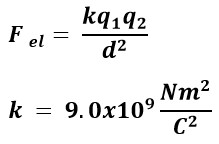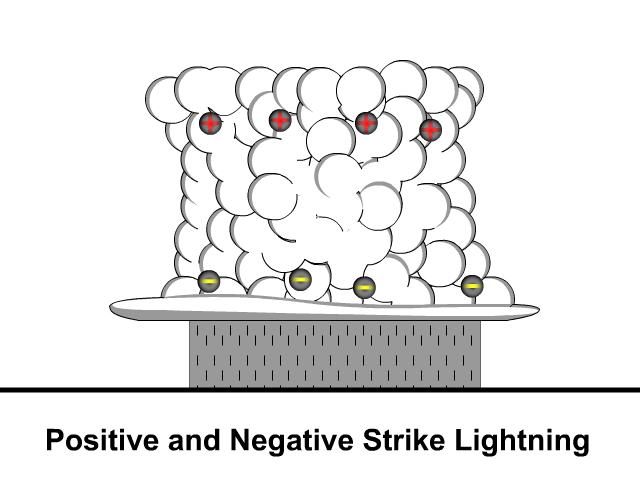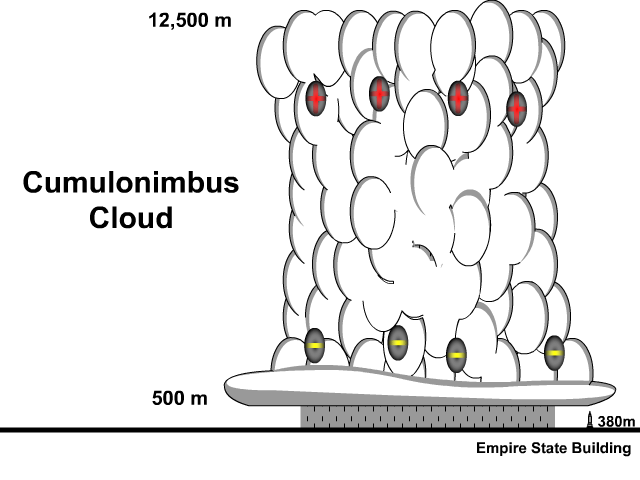What is Lightning?
It starts with the convection
Clouds are not just water vapor and not just light and fluffy. Water vapor, dust, and ice particles move in a cloud through convection. As various particles rub against each other charges separate through friction.
Cumulonimbus Clouds
Cumulonimbus clouds are highly active with powerful updrafts which can be seen in the height of cloud formation. These clouds typically start around 500 meters up and reach a height of around 12,000 meters. These clouds have been recorded as tall as 22,860 meters (75,000 feet) in the tropics.
Solar radiation heats up and causes the moisture filled air to rise. As air rises it begins to cool. An increasing cloud height, created by updraft, follows with a water vapor cooling and condensing. The condensing water vapor creates precipitation and heavier particles dropping produce a downdraft as air follows.
Charge Location in Cumulonimbus Clouds
Heavier particles gain more negative charge and gravity brings a negative charge to the bottom of a cloud. So this leaves the bottom of a cloud more negative and the top positively charged.
As opposite charges build in a cloud and ground a potential difference builds. The potential difference is related to the how much an electron wants to flow. The potential difference and electrical field that builds ionizes the humid air. Ionized air becomes more conductive creating a temporary path to the ground. The arc which is the lightning bolt you see results. Electrons flow quickly from the cloud to the ground in negative strike lightning or ground up during a positive strike.
Why is negative strike lightning weaker than positive strike lightning?
This question can be answered after understanding Coulombs Law.

The top equation is called Coulombs Law. The Coulombs Law constant, variable (k), is a electrostatic constant that relates charges to force when a specific distance away. The q1 and q2 variables represent Coulombs of charge 1 (q1) and charge 2 (q2). Distance (d) is the distance, in meters, two objects are apart. Distance is squared here which means it inversely proportional to the square of the separation. In other words, force decreases rather quickly as charged objects are further apart.
Less powerful negative strike lightning
The bottoms of clouds are the most negative part of an active cloud. The negatively charged bottoms of clouds induce the ground causing electrons to move deeper and leave the surface positive. When there is enough charge built up to ionize the air electrons flow from cloud to the ground. Grounding occurs as electrons flow flow through the ionized air leaving a more neutral cloud bottom. Since the bottoms of clouds are closer to the ground it requires less charge to create enough potential difference to ionize air. Since there is less charge necessary the lightning strike is weaker.

Strong Positive Strike Lightning
The positively charged top of the clouds are further away from the ground. Therefore it takes a much greater potential difference to ionize the air for an arc. The ground is induced negative as more electrons move to the surface. Once air is ionized conduction can occur, electrons will flow from the ground up to neutralize the positively charged clouds. Since a much greater charge is necessary for positive strike lightning a much greater current, flow of electrons, will occur.
Links
- To the Conduction, Induction, and Friction Page
- Back to the Electrostatics Main Page
- Back to the Stickman Physics Home Page
- For video tutorials and other physics resources check out HoldensClass.com
- Find many of your animation resources in one place at the StickMan Physics Gallery
- Equation Sheet

